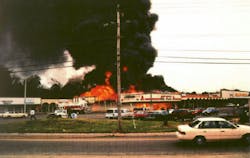Chesapeake (VA) Auto Parts Store Roof Collapse Double LODD 1996
Fifteen years ago, on March 18, 1996, two firefighters were killed in Chesapeake, Virginia when they became trapped by a rapidly spreading fire in an auto parts store and a pre-engineered wood truss roof assembly collapsed on them. The cause of the fire was an electrical short created when a power company truck working in the rear of the building drove away with its boom in an elevated position, accidentally pulling an electrical feed line from the main breaker panel at the rear of the store.
Post-incident investigations indicate that the electrical fault may have sparked multiple points of fire origin throughout the roof structure of the building, due to improperly grounded wiring. At the time of the report issuance, this was exemplified as another incident illustrating the rapid failure of lightweight construction systems when key support components are involved in a fire. The report pointed out the importance of prefire planning and accurate size up by fire companies to determine the risk factors associated with a fire in this type of construction.
Lessons regarding importance of initial company actions, constant re-evaluation of action plans, strong command and coordination of units on the fireground, and recognition of signs of impending structural failure were also reinforced.
Fifteen years later, reading through any number of NIOSH, USFA or NFPA reports, similar issues, challenges and operational factors resonate and continue to shape and challenge today’s fire ground operations.
It is without exception that the knowledge and insights being gained by the recent and past UL and NIST Research Studies coupled with the recommendations, from the NIOSH Fire Fighter Fatality Investigation and Prevention Program (HERE)Today’s fire ground is changing at a very rapid pace as it relates to the continued evolution, transition of engineered structural components and systems (ESS). Are you prepared, knowledgeable and understand that new strategic and tactical approaches are required?
One of the most significant actions initiated by the Chesapeake Fire Department was the implementation of a Truss Identification Program (TIP). Take a look at a past posting on CommandSafety.com where we published on an overview of truss and engineering component systems across the United States HERE.- For the comprehensive overview of the event, go to Buildingsonfire.com HERE
SUMMARY OF KEY ISSUES
Staffing : The first alarm response provided a small attack force with limited capabilities. The full response brought only 10 personnel.
Size-up : The first arriving company officer was not able to determine the location and extent of the hidden fire.
Pre-fire plan information: This complex required a pre-fire plan due to the complex arrangement, multiple occupancies, mixed construction, lack of fixed protection, limited access and difficult water supply problems. The first-due company did carry a pre-fire plan that showed the layout of the shopping center and the floor plan for the auto parts store, but the prefire plan was not referenced by the crew during the fire.
Delayed response: The first arriving company was on the scene alone for several minutes with only 3 personnel. The back-up companies had long response times. The lack of evidence of a working fire prompted the initial incident commander to return some of the responding units, resulting in even longer response times.
Water supply: The first-in company did not establish a water supply. This required the second engine company to be committed to this task.
Incident command: The battalion chief was faced with a complicated and rapidly changing situation. He was not able to effectively transfer command from the initial officer and direct the operations of widely separated units.
Operational risk management:The officers involved in the initial part of the operation had to make critical risk management decisions with limited information.
Accountability: Accountability for the personnel operating in the hazardous area was not established prior to the structural collapse. As the situation became critical, no one realized that a crew was still inside the building.
Rapid intervention crew: Additional crews did not arrive in time to assist the crew that was in trouble inside the building.
Radio communications: The lack of a clear radio channel for fire ground communications caused serious problems with command and control of the incident, including the failure to maintain communications with the crew inside and the failure to hear their request for assistance.
Lightweight construction: The roof collapsed quickly and with very little warning. This should be anticipated with a lightweight wood truss roof assembly. This hazard was not recognized by the crews on the scene.
About the Author
Christopher J. Naum
CHRISTOPHER J. NAUM, SFPE a Firehouse® contributing editor, is a 40-year fire service veteran and a national instructor, author, lecturer and fire officer. He is an authority on building construction issues affecting the fire and emergency services and a former fire command officer, architect and fire protection engineer. Naum is a technical consultant and reviewer to the NIOSH firefighter fatality investigation and prevention program, an NFFF Firefighter Safety Advocate and formally served on the Board of Directors of the ISFSI and the IAFC Safety, Health & Survival section and faculty at the National Fire Academy. He was the 1987 ISFSI George D. Post National Fire Instructor Award recipient. Naum is the executive producer of Buildingsonfire.com and FiregroundLeadership.com, sites dedicated to building construction, adaptive fire command and firefighter safety.

